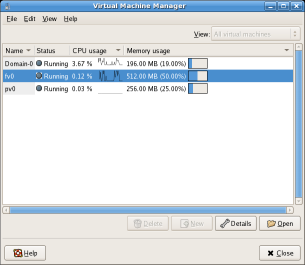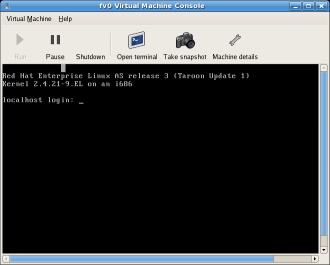Connecting to a hypervisor
The initial dialog for opening a connection to a hypervisor. The remote Xen connection is not implemented yet. The URL field allows connection to any libvirt backend, for example the backend for testing apps accepts a URI of
test:///default. Unless running as root, it is typically neccessary to open a read only Xen connection.
Host virtual machine summary
The host summary window lists all running virtual machines and current resource utilization. The set of displayed fields for resource utilization can be configured, showing/hiding metrics as required. Clicking on a domain brings up that guest's graphical console. The details button will display the dialog for view full performance statistics. Compare with a scan of the design mockup
Virtual machine performance details
The guest details dialog presents graphs of the live resource utilization data available from the hypervisor. At a future date this will be extended to include a feed of fine grained data from within the guest OS, allowing CPU time to be broken down to user, system, idle, iowait, nice categories. The UUID is a globally unique identifier for the VM which remains with it even across migrations. Compare with a scan of the design mockup
Virtual machine configuration
The guest configuration dialog is where changes can be made to the resource allocation, or virtual device setup of a guest domain. Some aspects such as memory allocation, virtual CPU count will be tunable on-the-fly, while others will be saved, to be applied next time the domain is started. Most of this dialog is currently non-functional. Compare with a scan of the design mockup
Virtual machine graphical console
The graphical console is connected using the RFB protocol, since the Xen guest domain provides a VNC server exporting its virtual framebuffer. If authentication is requird to access the display, this will be prompted for before allowing access to the display. A future Xen release will enable the framebuffer even for para-virtualized guests. Compare with a scan of the design mockup




